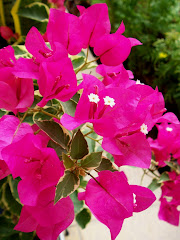P.7011 Aug-22, bought a pot of Hydrangea with greenish buds from Tesco, Damansara Mutiara.
I decided on this pot to buy because the leaves looked healthy; so silky, shiny dark green. Terribly excited to know the bloom color in anticipation.
Leaves are thick - isn't that a hardy plant?
P.7094 A week later, I planted Hydrangea into flowerbed. After researched on growing condition and plant-adjusting period, I replanted Hydrangea from pot into the bed, next to Marigolds and Zinnias, where there will be shade from 4pm onwards.
P.7109 A check on Hydrangea 3 days later - seems to be doing well since planting.
P.7195 2 days later. Oh look! Buds are unfolding.
P.7228 Its bracts seem to be stretching out as if to leave some space (clearance) for blooming.
P.7247 A day later it rained like 'nobody's business'. Hydrangea pretty steady as compared to Marigolds and Wrightia.
P.7275,7270 Can see some bloomed into flower, 5 petals with a ball in the center. At this stage, I'm thinking this could be Hydrangea 'Annabelle' species, pale-greenish blooms. I was really hoping for 'Endless Summer' variety.
P.7277,7283 There's unmistakable bluish tinge at the tip of petals. Anticipating ... *fingers crossed*
September gardening checklist - gardeners welcome the cooler temperatures and perfect planting season.
To encourage Hydrangea to bud; a) at least three to four hours of direct sun, preferably in the morning, b) Low-nitrogen fertilizer, c) no pruning but if they are trimmed, it usually results in a drop in bloom production for a year of two, and lastly d) frozen roots cause stems with blooms-to-be to die back - mulch in the summer (to conserve moisture and keep the roots cool).
p.7297,7310,7318,7330 My heart dropped at this sight. It hasn't rained for a week, temperatures consistent at 90 deg F day and night and windy.
I was careful watering during early morning and after sunset to prevent root rot. Been checking its leaves for any signs of fungal disease or insects. It's stem and leaves looked healthy green. The flowers seems soft, a few singed at tip of petal. This droop has been like this day and night for 2 days; I had to find some kind of support flexible and small from damaging its big leaves to hold the flowerhead.
Further research, I believe my cultivar "H. Macrophylla" with bloom in a shape of 'mophead'. Currently pale-green, so it could be 'Annabelle' - gardeners advise this type requires some staking as the stem is soft to support its mophead. Moreover it tend to wilt during high heat and windy weather. This Hydrangea particularly prefer morning sun and afternoon shade, had me comtemplating to dig it up, re-pot and relocate at courtyard. Family advised to give it time to settle - it needs some toughening up and patience. I complied.
Pic left, staking Hydrangea anchored with deadwood of Lantana and 'lidi' (part of dried palm oil, which was dried, gathered and tied into a broomstick). This staking on the drooping side. Pic right, Hydrangea seedlings - that is sooo cool!
Hydrangea to combat autoimmune diseases? A drug, called halofuginone, made from made from Febrifugine, and Chang Shan (Dichroa Root) could be used to treat multiple sclerosis (MS), psoriasis and some forms of diabetes and arthritis; these occur when the immune system attacks the body. Did you know? Hydrangea root has traditionally been used to relieve inflammation and 'cleanse' the joints.
Chang Shan (Dichroa Root) is one of the 50 staple herbs of Chinese medicine. North American Cherokee Indians use Hydrangea Root or Hydrangea strigosa, as traditional medicine. An extract of hydrangea leaf is also said to have anti-malarial properties.
Update Sep-22: So happens 'Chang Shan' in Chinese is called Blue Evergreen Hydrangea, Chinese Quinine (scientific name Dichroa febrifuga), is very different from Hydrangea Arborescens (my plant pics), and it bears fruit like berries! Febrifugine (berries from Dichroa febrifuga) and Dichroa root are used in a drug called halofuginone.
To 'Sclero-Eze' - Thanks for the clarification ;-)



















1 comment:
It should be noted that hydrangea root and Chang Shan are two totally different herbs!
According to Wikipedia there are over 75 different flowering species of hydrangea. The Hydrangea Root sold in the U.S. is actually Hydrangea Arborescens. Its common name is Seven Barks, Wild Hydrangea a plant native to America.
Hydrangea Root
Also known as
Hydrangea arborescens, seven barks, wild Hydrangea
Introduction
The hydrangea is a stately flower native to the southeastern United States and northeastern Asia. It grows near water, hence its name. The grayish roots used in herbal medicine have little odor but a sweet and pungent taste. The Cherokee Indians were the first known to have observed the usefulness of the herb in treating kidney stones.
Whereas, Chang Shan (Dichroa Febrifuga) is one of 12 species of Dichroa flower plants in the family of Hydrangeaceae. It is native to eastern and Southeastern Asia.
Taking one of these herbs and expecting it will have the benefit of the other is like eating carrots and expecting to receive the nutritional benefit of red beats.
Hydrangea Root (Seven Barks) has absolutely no potential to treat autoimmune diseases.
However, the effectiveness of Chang Shan for the treatment of autoimmune disorders merits full examination!
Halofuginone is a synthetic analog made from Febrifugine, and Chang Shan (Dichroa Root - Latin botanical name) is the organic source for Febrifugine.
Halofuginone is an antimalarial drug and antimalarial agents have been shown to improve skin problems, joint problems and ulcers associated with autoimmune conditions. Physicians also sometimes prescribe antimalarial medications, such as hydroxychloroquine or chloroquine phosphate, to treat scleroderma, lupus, rheumatoid arthritis and other conditions that affect the skin. The usual timeline to see improvement with these drugs is between four to twelve weeks.
Similarly, in using the antimalarial herb Chang Shan one may expect a similar timeline of four to 12 weeks for improvement with six to eight weeks being the norm.
Post a Comment